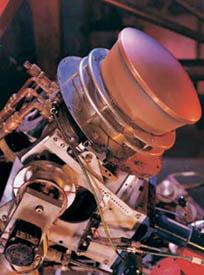(Excerpted from: "RTNS: A Tool for Studying Neutron Damage," Energy & Technology Review, Lawrence Livermore National Laboratory, March 1978; with material added)
The success obtained with magnetic confinement of plasmas in tokamak devices, first in the Soviet Union and then in the United States, led in the early 1970s to the decision to accelerate the US program to produce fusion power reactors. The resulting effort was structured into two subprograms: one to address the remaining physics uncertainties of plasma confinement and the other to address the engineering feasibility of fusion reactors. Of the engineering problems associated with fusion reactors, one of the most difficult to study without having a working fusion test reactor is the damage produced by the 14-megavolt (MeV) neutrons from the reaction.
LLNL’s involvement with intense 14-MeV sources began in 1966 with the installation of the Insulating Core Transformer accelerator, which was used to bombard a target of tritium absorbed in titanium and produce 2 x 1012 14-MeV neutrons per second. By 1976, the capability—known as Rotating Target Neutron Source (RTNS-1)—was able to produce 6 x 1012 neutrons/second. In 1978, a new facility (RTNS-2) was brought into operation capable of producing higher flux: 4 x 1013 neutrons/second. Experiments using RTNS-2 were conducted until 1987.
Using the RTNS-1 and -2, experimenters from Lawrence Livermore and other laboratories measured sputtering coefficients, hardening of metals (measured by change in yield strength of sample), and change of critical current in superconductors resulting from 14-MeV neutron irradiation. The results of these measurements indicate that damage processes that depend on total defect production scale about as expected with neutron energy. Damage processes dependent on the type and distribution of clustered defects do not scale as expected. Change in lattice parameters, detailed microstructure, yield strength, superconducting properties, and optical absorption do not scale with damage energy deposited. The results demonstrated that simple extrapolation of fission reactor experience is inadequate for fusion reactor design decisions.





